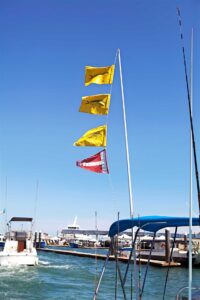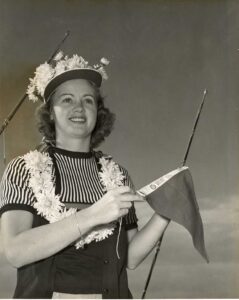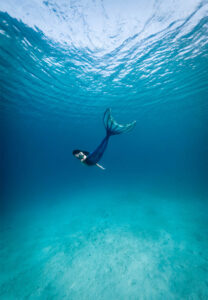I’ve never had much luck saltwater fishing. My first outing as a young boy was holding a handline over the side of my grandfather Pop Hunter’s motorboat in the shallow bay behind Alligator Point east of Apalachicola, Florida. Pop and my father were after redfish, and I wasn’t expected to catch anything. Sit and be quiet, they said. So I did, until something grabbed my line, and I let out a scream.

My grandfather snatched the line and began battling a strong fish with just his tough freckled hands. That fish turned out to be a small hammerhead shark! When he finally pulled it onboard, he tossed it at my feet where it thrashed about, and I began screaming again — certain it was going to bite me — until Pop threw it back in the bay. He thought it was hilarious and told the story repeatedly that summer. Somewhat traumatized, I didn’t go saltwater fishing again for years. When I finally did, all I managed to hook was a four-inch starfish. Like Pop, the fishing boat operator laughed. It was a first, he said, and he lamented that he didn’t have an appropriate starfish flag to hoist for our return trip to the dock.
Spend time around harbor docks and marinas, especially in the afternoon when the fishing boats come in, and you’ll undoubtedly notice rectangular flags featuring different kinds of fish fluttering on outrigger halyards. Though they might look decorative, they’re not. These fish flags, more formally referred to as “capture flags,” are colorful signals to let others know which fish were biting that day. It’s a tradition born in the days before daily fishing reports began to appear in newspapers and on radio.
The earliest capture flags on record are attributed to The Tuna Club of Santa Catalina Island, California, a private fishing club started in 1898 by Los Angeles Times editor Dr. Charles Holder for the southern California and Hollywood elite. The Tuna Club refers to itself as the oldest fishing club in the United States, and it’s still going strong.
Charlie Chaplin, Bing Crosby, Cecil B. DeMille, William Wrigley and George S. Patton were among its early members. Teddy Roosevelt was an honorary member. Members flew large colored flags on their boats to alert their fellow anglers when they caught tuna, swordfish and marlin. The practice quickly spread, and sport fisherman and charter boat captains on both coasts began hoisting flags to announce their catch as they pulled into the docks.
In Florida, the West Palm Beach Fishing Club (WPBFC) added a different twist to the fish flag. Founded in 1934 during the Great Depression, the WPBFC’s mission was to promote fishing to lure visitors to the Palm Beaches and stimulate the local economy. Given the proximity of the Gulf Stream and its big game fish, the club initiated the Silver Sailfish Derby fishing competition, a celebration of one of the world’s most elegant and iconic sport fishes. The Derby was the first serious billfish competition in the country. It quickly became the “in thing” to do for wealthy tourists. And it still occurs every January.

Here’s the twist. Club members soon became concerned that too many sailfish were being caught and not consumed or mounted as trophies. As a result, WPBFC established new rules to restrict the number and size of sailfish captured and brought aboard boats during the derby. To help incentivize the policy, they encouraged contestants to raise a triangular red pennant to signify smaller sailfish that were caught and released so they could still be given their proper due. The national media seized on it with vigor. And in turn, the red pennant inspired other contests geared toward catch-and-release fishing and helped change the nature of big game fishing. It also furthered the practice and the prevalence of flying fish flags.
As sport fishing became more popular and accessible to Americans in the 1960s and 1970s, so too did fish flags. This was driven in part by a growing number of game fishing tournaments with affordable entry fees and guaranteed prize money. Competitors wanted to show off their fishing prowess, so flag companies were more than happy to begin making and supplying 12″x18″ canvas and nylon flags featuring the most popular varieties of sport fish — marlin, swordfish, sailfish, tuna, mahi-mahi, wahoo, etc. that we still see on boats today.
Sharks, by the way, merit a capture flag. You can’t miss it. It’s usually a vibrant red color and features a white shark. To the best of my knowledge, there’s still not a starfish flag.
HOW TO FLY YOUR FISH FLAG

You need not worry about official regulations for displaying fish capture flags. Protocols vary from location to location. That said, more experienced fishermen tend to follow some informal rules of thumb.
- Fish flags are generally flown on the port or starboard outrigger halyard and in order of merit, meaning game fish with bills (marlins, swordfish and sailfish) go at the top and others follow in order of size from largest to smallest. Shark flags are often flown on the bottom.
- It’s appropriate to fly a flag for each fish caught, though some say you should only fly one yellow mahi-mahi flag no matter how many you land. In Hawaii, some boats will run a black pirate flag beneath the mahi-mahi when more than 20 are caught.
- Never run flags all the way to the top of the rigger; keep them about three quarters up the rigger and spaced at least six inches apart as this is optimal for visibility.
- Flying a fish flag upside down is the most common way to signal a successful catch and release. Some fishermen, however, prefer to fly a fish flag right side up with a smaller square red flag beneath it or a red T-flag to indicate a fish was tagged and released. Red pennants are still sometimes used.
- A fish flag should never hang on the halyard for more than a few hours, though charter boats might fly them for 24 hours to help attract clients.





